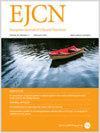患有慢性神经性厌食症的老年妇女:随着时间的推移,对营养不良的适应情况各不相同。
IF 3.6
3区 医学
Q2 NUTRITION & DIETETICS
引用次数: 0
摘要
导言:对老年女性神经性厌食症(AN)的描述主要是通过综述或病例报告,侧重于精神特征,而没有对其营养和激素状况进行全面评估的综合研究。本研究旨在描述一组 35 岁以上患有神经性厌食症的女性(AN35),并将她们与患有神经性厌食症的年轻女性(ANY)和体重正常的对照组参与者进行比较:方法:收集并比较三组女性的人体测量、代谢、营养和精神参数:50 名 35 岁以上女性厌食症患者、37 名 35 岁以下女性厌食症患者和 38 名对照组女性:AN35的平均病程为271 ± 19个月,其中94%为慢性型,58%为限制型。尽管 AN35 的体重指数与 ANY 相似,但 AN35 的参数变化更大,包括肝酶(p = 0.007)、游离 T3(p = 0.0046)和瘦素(p 3)更高。半数 51 岁以上的患者尽管营养不良,但促性腺激素水平较高。此外,AN35 组中有 50%的人骨折,T 值下降至-2.5 以下(p 结论:AN35 组中有 50%的人骨折,T 值下降至-2.5 以下:老年妇女的神经性厌食症主要是慢性的。随着年龄的增长,营养参数也会发生变化,这表明存在明显的异质性,能量平衡和体重设定点可能会发生变化。并发症可能很严重,会改变生活质量,有时甚至可能致命。这些研究结果突显了能量平衡随年龄变化的潜在适应性,应有助于临床医生的临床实践。本文章由计算机程序翻译,如有差异,请以英文原文为准。


Older adult women with chronic anorexia nervosa: heterogeneous adaptation to undernutrition over time
Anorexia nervosa (AN) in older adult women is primarily described through reviews or case reports focusing on psychiatric traits, with no comprehensive studies evaluating their complete nutritional and hormonal profiles. This study aimed to describe a group of women with anorexia nervosa aged above 35 years old (AN35), and compare them with young women with anorexia nervosa (ANY) and normal-weight control participants. Anthropometric, metabolic, nutritional, and psychiatric parameters were collected and compared among three groups of women: 50 AN35, 37 ANY, and 38 controls. AN35 exhibited a mean disease duration of 271 ± 19 months, with 94% chronic forms and 58% restrictive types. Despite having similar BMI as ANY, AN35 displayed more altered parameters, including higher liver enzymes (p = 0.007), free T3 (p = 0.0046) and leptin (p < 0.0001); and lower albumin (p = 0.0029), and white cells (p < 0.0001). AN35 showed significant heterogeneity in hormonal adaptation, such as free T3. Half of the patients aged above 51 years revealed high gonadotropin levels despite being undernourished. Additionally, AN35 groups presented with 50% of bones fractures, decreased T-scores under -2.5 (p < 0.0001 for femoral), and altered micro architectural HRPQT parameters compared to ANY. Anorexia nervosa in older adult women is predominantly chronic. Nutritional parameters changes with age suggests a significant heterogeneity and possible adaptation of energy balance and bodyweight set point for others. Complications may be severe, altering the quality of life, and sometimes potentially lethal. These findings highlight the potential adaptation of energy balance with age, and should assist clinicians in clinical practice.
求助全文
通过发布文献求助,成功后即可免费获取论文全文。
去求助
来源期刊
CiteScore
10.60
自引率
2.10%
发文量
189
审稿时长
3-6 weeks
期刊介绍:
The European Journal of Clinical Nutrition (EJCN) is an international, peer-reviewed journal covering all aspects of human and clinical nutrition. The journal welcomes original research, reviews, case reports and brief communications based on clinical, metabolic and epidemiological studies that describe methodologies, mechanisms, associations and benefits of nutritional interventions for clinical disease and health promotion.
Topics of interest include but are not limited to:
Nutrition and Health (including climate and ecological aspects)
Metabolism & Metabolomics
Genomics and personalized strategies in nutrition
Nutrition during the early life cycle
Health issues and nutrition in the elderly
Phenotyping in clinical nutrition
Nutrition in acute and chronic diseases
The double burden of ''malnutrition'': Under-nutrition and Obesity
Prevention of Non Communicable Diseases (NCD)

 求助内容:
求助内容: 应助结果提醒方式:
应助结果提醒方式:


